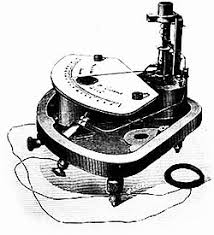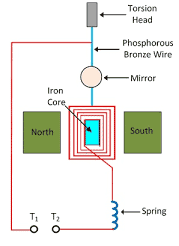The ballistic galvanometer is an instrument, which is used to measure or indicate current in a closed circuit. The galvanometer also is known as PMMC instrument, works on the principle of permanent magnet moving coil. The force is generated on the coil, due to Lorentz Force Law. Due to the interaction of fluxes, the pointer in the meter is deflected. Once the pointer is deflected, different torques are exerted on the pointer to make pointer stop at its steady-state position. The different torques are, deflecting torque, control torque, and damping torque. In the ballistic galvanometer, the damping torque is almost zero. For that reason, it is called a ballistic galvanometer. It can be used as an ammeter or voltmeter.
What is a Ballistic Galvanometer?
The ballistic galvanometer is a current measuring instrument with zero damping torque. It is also called as frictionless, damping less galvanometer. For this galvanometer, the damping constant is zero. The basic principle of galvanometer Lorentz Force Law, according to which, force is exerted on the current-carrying coil when it is placed under the influence of the magnetic field.

Ballistic Galvanometer
When the force is exerted, the coil moves, as per the magnitude of the current flowing in the coil. That is obviously proportional to the measured current. So whatever is the value of the current to be measured, that current when flows through the coil or a pointer, in this case, a force is exerted on that pointer when it is placed under the influence of the magnetic field. Just like DC motor, where the current-carrying coil, rotates due to the interaction of fluxes, the concept is the same here also.
Ballistic Galvanometer Diagram
The basic structure of the ballistic galvanometer is shown in the diagram. It consists of two magnetic poles North and south. In between the two poles, a coil is placed. The col is a current-carrying coil. In the case of instruments, it may be also a simple pointer, which points towards the measured current value. The pointer when placed under the influence of magnetic poles, a force is exerted on the pointer, due to which it deflects and measures the current. The current measured is given at the ends of T1 and T2. A mirror is used just below the pointer to avoid any parallax errors. It must be noted that we must take the reading such that, the pointer and its image in the mirror, both superimpose together. Any reading by looking at the pointer sidewards introduces parallax errors. Phosphor bronze is used along with the coil.

Ballistic Galvanometer Design
The purpose of phosphor bronze is to minimize any errors due to temperature. The phosphor bronze has the least coefficient of temperature. So placing a phosphor bronze will reduce the errors. A torsion head is placed to damp any oscillations in the coil. The spring that is connected at the beginning of the pointer, provides restoring torque to the galvanometer. The purpose of restoring torque is to bring back the pointer to its initial position after the supply has been removed.
Theory of Ballistic Galvanometer
A galvanometer is fundamentally a permanent magnet moving coil device, which measures or indicate any change in the current. For the moving coil principle, a current-carrying coil has to be placed under the influence of a magnetic field. When the coil carries current, it produces its own magnetic field due to flux linkages. Similarly, we have a magnetic field due to the magnetic poles which are placed across the coil. So we have two magnetic fields. The interaction of these two magnetic fields exerts a force on the pointer. The force exerted is proportional to the current to be measured. So the coil or pointer deflects.
Once the coil deflects, it also produces three torques. The first one is deflecting torque. The purpose of this torque is to deflect the pointer in the forward direction. Because of this torque, the pointer moves ahead. Next is controlling torque. The control torque tries to stop the pointer exactly at the point proportional to the magnitude of the current to be measured. For example, if we want to measure 10A, the control torque will try to stop the pointer at 10A. But the pointer will not stop instantly. The pointer will oscillate at that position. In order to damp those oscillations, damping torque comes into the picture. The damping torque damps the oscillations of the pointer. For a ballistic galvanometer, the damping torque is zero. In other words, ideally, the damping constant of the ballistic galvanometer is zero.
Construction
A basic structure of the galvanometer is shown in the figure. The functionalities of each block are discussed.

Ballistic Galvanometer Construction
Magnetic Poles
The two magnetic poles are required to create the necessary magnetic field. The poles may be separately excited, or in some cases, we may use permanent magnets also. For the deflection of the coil/pointer, the magnetic poles are required. If the coils are excited with supply, the supply must be DC. AC excitation of the field poles won’t produce the necessary torque.
Phosphor Bronze Wire
The wire used for the suspension of the coil is made up of phosphor bronze. The reason for using phosphor bronze material is, phosphor bronze has low torsional constant. It allows the coil to suspend easily. Also phosphor bronze is nonmagnetic. So it does not comes under the influence of magnetic poles. And phosphor bronze does not oxidize easily. This allows the suspension wire not to get rusted due to atmospheric conditions.
Mirror
The mirror is used in the galvanometer to avoid parallax errors. Parallax error means, error in taking the readings of the meter. One may note the reading of the pointer by looking sideways. i.e. from the left side or right side. So different reading will come. So to avoid this, a mirror is placed such that, the position of the pointer and its reflection should superimpose, and then readings should be taken. This would avoid parallax errors.
Torsional Head
The torsional head is used to control the position of the coil. This is important for accuracy in the meter. The torsional head also adjusts the zero settings of the meter.
Springs
The hairsprings are used to make the deflection of the pointer, proportional to the magnitude of the quantity to be measured. It also helps to provide restoring torque to the galvanometer.
Ballistic Galvanometer Working
It works on the concept of Lorentz Force Law, according to which whenever a current-carrying coil is placed under the influence of a magnetic field, a force is exerted on the coil. In this case, when the current flows through the coil and impulsive force is exerted on the coil. The force is proportional to the magnitude of current passing through the coil. To settle the torque to its steady-state position damping torque is used in other moving coil instruments. But in the case of the ballistic galvanometer, damping torque is zero. It’s damping constant is zero. That’s the reason the word ballistic is used.
Calibration of Galvanometer
Calibration is a process in which changes are made in the instrument so that the instrument can maintain accuracy. It is the process of configuring the instrument so that it produces accurate results. In this process, the instrument constants are calculated. For a ballistic galvanometer, different methods like calibration using a capacitor, calibration using mutual inductance, etc. are used to calculate the meter constants.
Advantages
The advantages of the ballistic galvanometer include the following.
- Linear Scale. The scale of the galvanometer is linear.
- It is highly sensitive.
- It is accurate and precise
- The toque to weight ratio is high. (This avoids errors)
- It is not affected by stray magnetic fields
Disadvantages
The disadvantages of the ballistic galvanometer include the following.
- Since it works on the principle of PMMC, it can be used only of DC measurements.
- Due to components such as springs, permanent magnets, etc. it develops errors due to aging.
Applications
The applications of the ballistic galvanometer include the following.
- Used in Wheatstone bridge, to detect the presence of current in the loop
- Can be used to measure current by connecting a low resistance in parallel to it.
- Can be used to measure voltage by connecting a high resistance in series to it.
- Detecting errors in communication cables
- Positioning the pen in analog strip chart recorders, electrocardiographic, etc.
Know more about Wheatstone Bridge MCQs.
Know more about Moving Coil Galvanometer.
Hence we have seen the operating principles of the ballistic galvanometer and its applications. Due to its high sensitivity, the galvanometer immediately detects the presence of current in a circuit. At his point, it would be interesting to think that, how a galvanometer can be converted into an ammeter? Or how a galvanometer can be converted into voltmeter?